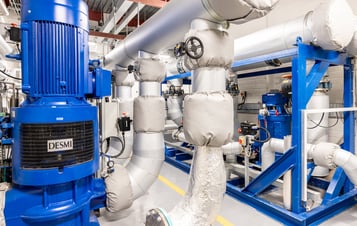| Amount | Type |
| heating | 33 |
| other | 67 |
Domestic heating accounts for 33% of the UK's carbon emissions.
Most UK homes are heated using natural gas boilers, but there are far more resource-efficient ways for us to heat our homes.
Let’s take a closer look at how gas from deep in the Earth becomes heat for your living room.
Video player requires marketing cookies.
To view this content please click here to allow marketing cookies.

Natural gas is a fossil fuel, which means it forms when the remains of plants and animals are subjected to pressure beneath the Earth's surface over millions of years.
It is a finite resource, meaning it cannot be produced at the same rate at which our populations are using it and, based on current consumption patterns, will eventually run out.
Much of the UK's natural gas comes from the oil and gas fields deep beneath the sea bed in the North Sea. Prospecting for oil and gas fields is a difficult and costly process that involves drilling beneath the sea floor. Once a gas field is discovered, a floating drilling platform is constructed, which is then towed out to sea and anchored in place.
Our supply of gas from the North Sea gas is running out. The UK now imports more gas than is exported which means we increasingly have to rely on other countries for our energy security. This is particularly relevant in the context of a volatile energy market.
Once the gas is extracted, it first has to be shipped to a refinery, where it is broken down into its constituent parts so it can be used as fuel.
| Amount | Type |
| heating | 33 |
| other | 67 |
Domestic heating accounts for 33% of the UK's carbon emissions.
It arrives in the UK via four European pipelines or is shipped in on tankers. Gas is then distributed into UK homes by eight gas distribution networks, where your boiler burns it as fuel to heat a water tank. This hot water is pumped into the radiators in the rooms of your house, keeping them warm.
The burning of gas to generate heat inside your boiler accounts for around 30 percent of the UK’s emissions. These harmful emissions damage the Earth’s atmosphere, and contribute to the thousands of premature deaths associated with air pollution in our cities every year.

This natural gas, as with other fossil fuels, is a finite and precious resource that is running out. So, we need to make sure we're using it efficiently.
We need energy for lots of things, such as powering industry, transporting goods, lighting and heat. We use a lot of energy to do all these things and, in turn, rely on many resources to create that energy. We need to carefully consider which resources are applied to which application, to make sure we are using them as intelligently as possible.
With gas boilers, in order to heat our homes to a comfortable room temperature of 22°C, natural gas is first burned at 600°C which is the equivalent of "using a sledgehammer to crack a nut". There are other ways to heat homes without burning fuels to those high temperatures.
It's time to look at other ways to heat our homes and preserve our fossil fuels for when we really need them.

Economies of scale and market dominance are powerful forces that make it difficult to devise viable alternatives to heating our homes with natural gas.
Replacing old infrastructure with new networks naturally comes at an upfront cost, but we need to build a system that provides better value, uses the Earth's finite resources more intelligently, and which is also less vulnerable to fuel security problems associated with a volatile energy market.
We now have the technology available to make eliminating our dependence on fossil fuels a reality. During 2020's COVID-19 lockdown, for example, the UK went for two whole months without burning coal to produce electricity.
It's time to build on that progress and commit to transforming heat.
Although the majority of UK homes today are heated by gas, there are a number of low carbon alternatives and heat delivery methods to choose from.
A number of factors determine the cost of heating a building. As well as the delivery technology - such as a heat network or individual heat pumps, the building's location, environment and physical properties all play a part too. A 2020 report produced by Baringa Partners demonstrates that, in densely populated urban areas, where there is a high level of heat demand and multiple properties (both commercial and domestic) that can be served by the same piping, district heating is the most cost-effective solution. This is because the costs of the piping to supply heat and of maintaining the network can be shared.

Most UK homes are heated using natural gas boilers, but there are far more resource-effici...

UK homes are being encouraged to move to low carbon heating, but what are the benefits?

A heat network, also referred to as district heating, is a system of delivering heat to ho...

Heat networks are used in many parts of the world to deliver low carbon heat to homes and ...